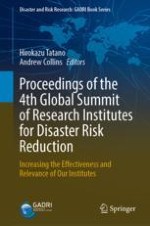2023 | OriginalPaper | Chapter
7. Harnessing Scientific Knowledge and Technological Innovation for Disaster Risk Reduction (DRR) in Sub-Saharan Africa-Case of Social Media
Authors : Desmond Manatsa, Lucy Sakala
Published in: Proceedings of the 4th Global Summit of Research Institutes for Disaster Risk Reduction
Publisher: Springer Nature Singapore
Activate our intelligent search to find suitable subject content or patents.
Select sections of text to find matching patents with Artificial Intelligence. powered by
Select sections of text to find additional relevant content using AI-assisted search. powered by
